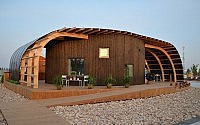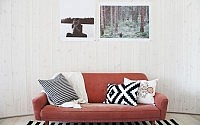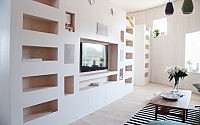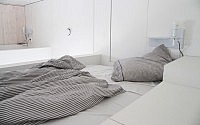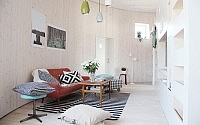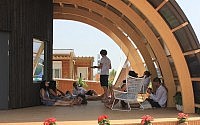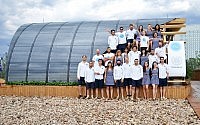Halo by Halo Team Sweden
Situated in Göteborg, Sweden, HALO is a socially sustainable home for four students, running on renewable energy from the sun.









Description by Halo Team Sweden
Over 25 students, Team Sweden, from Chalmers University of Technology in Gothenburg, Sweden designed and built HALO as their entry into the Solar Decathlon China which took place in Datong this past summer from August 2nd to August 13th. The students constructed HALO first in Sweden, dividing the house envelope in 30 prefabricated modules before disassembling and shipping the house to China for the competition.
Shared space is double space: HALO was designed using the underlying concept of shared space. HALO offers quality instead of quantity and giving added value while at the same time lowering environmental impacts. Keeping the total area low, a total interior space of 60 m², the students are offered large common spaces and smaller private areas. By sharing, our building is maximizing the use of the space, allowing the inhabitants to share habits, knowledge and friends.
The shape and name of HALO was inspired by the optical phenomenon that takes the form of a round shining circle around the sun. The round shape Of HALO’s structure provides maximum interior area while minimizing exterior perimeter, reducing heat loss potential. Halo’s shape also emphasizes the social character of the home as a meeting place at the same time it opens up to the outside letting the few but optimally placed windows to take in daylight, mainly from the south. The curved roof is the shelter, protecting from precipitation and wind, giving shade and creating protected outdoor spaces.
The roof is constructed of monocrystalline silicone photovoltaics laminated in thin acrylic plastic and coated with a high strength polymer. The cells were then applied to 10 mm thick double wall polycarbonate sheets which act as the waterproofing membrane for the roof. The solar panels are not just attached to the roof, they are the roof. Solar cells are often perceived as a limitation, due to strict module measures. Through HALO we’ve shown a potential for solar technologies to be truly integrated into the architectural design of a house.
The envelope has been designed using Passivehouse design principles, with heavily insulated walls, roof, floor and minimal openings. This allowed us to use a small simple HVAC system composed of off-the-shelf technologies and integrated into a simple flexible system that can be adjusted according to the location. The cooling, heating, and hot water are all provided by a small air handling/ heat pump unit with heat recovery which is located in a central core module allowing for shorter connections and simple distribution system.
Resting on Scandinavian traditions, Halo focuses on the usage of wood, both for construction and surface finishes. The white interior works as an empty canvas, where the inhabitants are encouraged to paint their own lives. A mixture between fixed and movable furniture allows for shifting interior styles and room layout.
The idea of “shared space is double space” goes beyond of what is termed sufficiency. We firmly believe that we should not try to convince people to individually consume less, but rather demonstrate the additional quality resulting from pooling resources.
- by Matt Watts